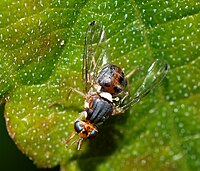
Photo from wikipedia
In most diploid organisms, mating is a prerequisite for reproduction and, thus, critical to the maintenance of their population and the perpetuation of the species. Besides the importance of understanding… Click to show full abstract
In most diploid organisms, mating is a prerequisite for reproduction and, thus, critical to the maintenance of their population and the perpetuation of the species. Besides the importance of understanding the fundamentals of reproduction, targeting the reproductive success of a pest insect is also a promising method for its control, as a possible manipulation of the reproductive system could affect its destructive activity. Here, we used an integrated approach for the elucidation of the reproductive system and mating procedures of the olive fruit fly, Bactrocera oleae. Initially, we performed a RNAseq analysis in reproductive tissues of virgin and mated insects. A comparison of the transcriptomes resulted in the identification of genes that are differentially expressed after mating. Functional annotation of the genes showed an alteration in the metabolic, catalytic, and cellular processes after mating. Moreover, a functional analysis through RNAi silencing of two differentially expressed genes, yellow-g and troponin C, resulted in a significantly reduced oviposition rate. This study provided a foundation for future investigations into the olive fruit fly’s reproductive biology to the development of new exploitable tools for its control.
Journal Title: Genes
Year Published: 2021
Link to full text (if available)
Share on Social Media: Sign Up to like & get
recommendations!